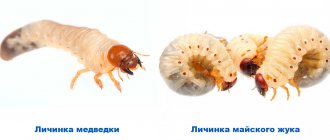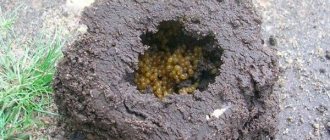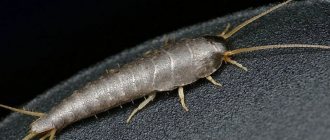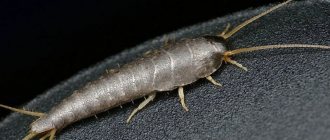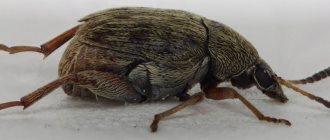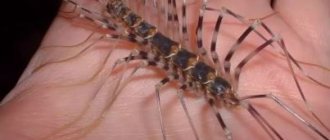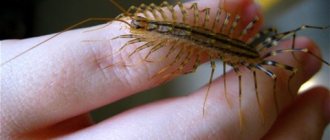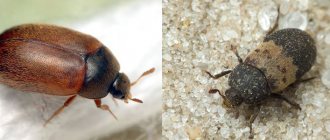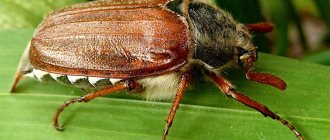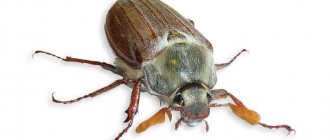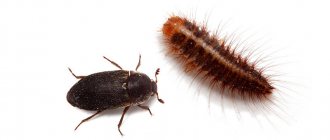The skin beetle larva is the main pest among all the skin beetles in the apartment. The fact is that in most species of beetles of the leather beetle family, adult individuals do not feed at all. That is, black, gray, or spotted beetles, which can often be found on window sills (they fly into apartments from the street) or on beds, do not gnaw, eat, damage, or cause any harm. But it is the larvae that are truly harmful, capable, in fact, of gnawing almost any organic substance.
For example, in the photo below are the larvae of the ham leather beetle, which can render any fur coat or leather product unusable:
And these are the carpet beetle larvae, just as voracious, but slightly less common in apartments than the previous ones:
You have probably already noticed that these larvae are not quite similar to the caterpillars we are used to. For most people not immersed in biology, the word “larva” is associated with the concept of “caterpillar”, or even “worm”. From a scientific point of view, this is incorrect, but at the everyday level it is quite convenient. The larva of the carpet beetle does not resemble either a caterpillar or a worm. And this is often associated with very real everyday problems: having encountered such a creature in an apartment, a person does not always perceive it as a pest, does not begin to fight these larvae in time, and over time there are so many of them that they begin to spoil very expensive things.
Fortunately, skin beetle larvae have qualities that allow you to get rid of them quickly enough. Therefore, let's figure out how to identify these pests in the apartment, how to find them and how to quickly get them out before they spoil something.
What does a carpet beetle larva look like?
The main distinguishing feature of the larvae of almost all skin beetles is the presence of a large number of long, stiff hairs on the body. In some species, this “fur” is so thick that it hides the body itself.
For example, this is what a mullein beetle larva looks like:
To an inexperienced eye, it may seem that the insect does not even have the characteristic worm-like body shape, but looks more like a tuft of fur.
In fact, the larvae of skin beetles have the same body shape as the larvae of other beetles. It’s just that this body is hidden behind thick hairs that form a very unique outfit.
In larvae of skin beetles of different species, the density and length of hairs on the body vary significantly. Thus, in carpet beetle larvae, the body itself is clearly visible and it is clear that they are to some extent similar to caterpillars:
And in the house leather beetle, the larvae are so shaggy that the body is not visible, and the hairs on the back of it form a kind of “tail”, the length of which is commensurate with the length of the body:
On a note
It is incorrect to call the larvae of skin beetles either caterpillars or worms. Caterpillars in science are called butterfly larvae; they have very characteristic features of the body structure that the larvae of skin beetles do not have. For example, butterfly larvae have several pairs of false legs on the back of the body, with which they can grasp branches or other supports. The larvae of beetles (including leather beetles) do not have false legs. The larvae of skin beetles have even less in common with worms - the worms themselves belong to a completely different class and even type of living creatures, and the similarities between them and the larvae of skin beetles end with the elongated shape of the body.
By the way, the hairs on the body of the larvae become thicker and longer as the larva itself grows and develops. Immediately after hatching from the egg, the larva is small, thin and almost naked - there are hairs on its body, but they are sparse and thin.
This photo, for example, shows what newly hatched carpet beetle larvae look like:
As the larva grows and feeds, its “fur” becomes thicker, longer, and in some species completely hides the insect’s body underneath, as if under a fur coat. This is what the last instar larva of the skin beetle looks like:
Be that as it may, it is the thick hairs on the body of the skin beetle larva that are the main identifying feature that allows you to distinguish it from any other insects living in the apartment. Due to such hairs, the appearance of the larva is so unique that once you see and identify it, you will no longer be able to confuse it with any other pest.
Control measures
What should you do to protect your home from voracious pests? How to get rid of moth larvae? In order for the fight against them to lead to the expected result, it is necessary to perform a number of the following actions:
- It is necessary to immediately inspect the shelves as soon as you see moths fluttering in your apartment, since this pest multiplies quite quickly. One moth is capable of laying approximately 400 eggs in its life, and the entire development cycle under favorable conditions can be completed in one month. Moreover, reproduction can continue all year round. Imagine, now, how many caterpillars one vagrant butterfly will produce and how many products and things its descendants will spoil.
- If caterpillars are found in food products, they should be thrown away immediately. Or, if there are few larvae, you should sort out the cereal, sift the flour through a sieve, and then bake in the oven at a temperature above 50 0C for 30 minutes. It is best to wash clothes and things in which clothes moth larvae have infested at 60 0C. If this is not possible, they should be shaken out and thoroughly fried in the sun.
- It is necessary to carry out disinfestation aimed at destroying flying butterflies. Aerosol preparations specially designed to combat the pest are best suited for this. The same means are used to get rid of clothes moth larvae.
- Wash the cabinets with soapy water and wipe all crevices with vinegar. Furniture and carpets should be thoroughly vacuumed.
If all these conditions are met, it is possible to get rid of house moths and their larvae quite quickly, and in order to prevent this pest from entering your home in the future, the following preventive measures must be observed:
- keep food products in glass or plastic containers with tight-fitting lids;
- do not make large reserves of cereals, flour, pasta and the like;
- check products before purchase to see if they contain larvae;
- cover the ventilation ducts with fine mesh;
- Put butterfly repellents in bags with winter clothes and shoes - mothballs, fragrant herbs, pieces of laundry soap.
Advice! Disinsection measures against butterflies and moth larvae must be carried out on the same day, otherwise new insects will hatch from the caterpillars left in the cereal and all efforts will go down the drain. It is necessary to inspect the room especially carefully to detect pupae. They will have to be collected and destroyed manually, since most chemicals do not take them.
You can learn how a clothes moth larva looks and moves from this video:
The sizes of these insects
The size of skin beetle larvae varies from half a millimeter at the stage of emerging from the egg to 9-12 mm before pupation in some species. Of course, the maximum body length of a larva depends on the size of the adult beetle: in species whose imagoes have a body length of 2-3 mm, the larvae grow to 4-5 mm, and in species whose beetles grow up to 8-9 mm, the larvae can reach up to 12 mm, and taking into account the length of the posterior hairs - 15.
In the photo, for example, it is noticeable that the unique “tail” of the skin beetle larva is not inferior in length to the body size of the larva itself:
In any case, the larvae of skin beetles are small and never reach the length of even a domestic cockroach. In part, such small sizes help them remain invisible to people for a long time, and due to this it is safe to grow and even turn into beetles and leave their own offspring even in completely clean and well-kept apartments.
Spider cocoons
For eggs
The spider's web was intended primarily for protection. Most types of cocoons have two layers: the inner layer is softer, the outer layer is stronger. The cocoon contains from 2 to 1000 eggs depending on the species. The fewer eggs in the cocoon, the more cocoons each spider creates.
For the victims
When approaching a victim caught in a web, spiders behave differently. Some bite the victim, paralyzing it, others quickly wrap the victim in a tight cocoon so that it cannot move. This is done due to the fact that sometimes the spider is much inferior in size and strength to its victim. He comes later, when the victim weakens or stops resisting.
For posterity
It’s amazing and touching how wandering spiders show care for their offspring. Many, obviously, had to see female wolf spiders running away from under their feet at the beginning of summer, with a soft round lump firmly attached to their abdomen. Not everyone knows that this is a cocoon containing many (several dozen) spider eggs. For many weeks, the spider carries a cocoon with her. The rate of development of embryos depends on the temperature of the external environment (air). With an increase in temperature of 10 degrees, the rate of egg incubation approximately doubles. Therefore, the spider, which usually prefers damp, shaded places, during the period of gestation of the cocoon, looks for open areas that are most warmed by the sun. By evening, due to the evaporation of water from the body, the weight of the already miniature animal is reduced by almost half! But only after sunset the female leaves the solarium, satisfying her thirst and gaining normal weight mainly due to dew. And the next morning, back in the sunshine, weather permitting. And the spider subjects itself to such voluntary torture for 2, 3 weeks.
Characteristic behavioral feature
In addition to the abundance of hairs on the body, the larvae of skin beetles differ from insects with a similar body shape by their very high mobility. In those moments when they catch your eye in the apartment, they are practically not in place for a second - each larva with an unexpected body shape and “pubescence” crawls, turns, bends and unbends, crawls over various obstacles with remarkable agility, and sensing danger, it accelerates even more. This agility contrasts greatly with her body shape, especially for humans who are accustomed to various worm-like creatures moving slowly and sluggishly.
It should be noted that skin beetle larvae are not always so mobile. Where they are safe and close to food, they are quite economical in expenditure of energy, and simply eat, rest, and sometimes make primitive cocoons of their web. They crawl quickly and are especially active where they are in an unsafe place, mainly when moving in search of food along routes that are new to them.
For example, here is a video of a house beetle larva crawling in an open place on fabric:
Actually, it is in such movements that skin beetle larvae are most often noticed. While they do not crawl far, they are not particularly visible - they spend most of their lives in secluded crevices, cavities, hidden from the eyes of people, forgotten boxes and bags of food, in cabinets that have not been opened for a long time, inside furniture. Here, if they are noticed, it is during rare or random repairs, inspections and cleaning. Most often, their hiding places are so inaccessible that it is difficult to find them in an apartment even with targeted searches, when it is well known that they live somewhere here.
This, by the way, is one of the reasons why it is not always possible to get rid of them. And you definitely need to get rid of them...
Cocoons of fictional creatures
- The alien from the movie "Arachnid" covered the victim with a cocoon, in which the larva fed on the semi-digested victim. The other cocoon was used by him for sleeping.
- Aliens often turn victims into cocoons and leave them next to their eggs.
- The cocoons contained vampires in the films Van Helsing (the stillborn offspring of Dracula) and The Shepherd (during transport by train).
- Cocoons are devices from the film of the same name and its sequel, in which the aliens were in a state of suspended animation.
- Mogwai, creatures from the films Gremlins and Gremlins 2: The New Batch, pupate before transforming into .
- Cocoon is an alien spaceship from the movie Earthling.
How dangerous are these insects?
The main danger of skin beetle larvae is their gluttony and indiscriminate eating. If in wild (or semi-wild) nature they feed mainly on the remains of dead animals - wool, dried and hardened meat, skins, skin, chitinous coverings of dead insects, feathers, sometimes even dry grass - then in apartments they look for substitutes for such food, and easily damaged:
- Fur
- Wool knitwear
- Leather shoes and clothes
- Carpets made of natural wool or cotton
- Various collections – herbariums, insect collections
- Skins
- Stuffed animals and birds
- Various animal products - cheeses, sausages, dried fish and meat, meat and bone meal, dog and cat food
- Cereals and groceries (by the way, they are not eaten by the larvae of all types of skin beetles)
This is, for example, what a fur coat looks like after encountering skin beetle larvae:
And it is clear that if, say, no one is particularly upset because of a kilogram of damaged cereal, then a chewed expensive fur coat, or good shoes with ugly furrows, is serious damage.
On a note
Skin beetle larvae can eat any tissue of the animal body, except bones. This is used in some museums: the remains of animals whose bones they want to preserve for collections are specially placed in a room where thousands of beetles and their larvae are located, and in a few days these voluntary cleaners “remove” absolutely everything from the bones, including ligaments, tendons and places muscle attachments. After their work, the bone will not rot or stink - there is simply nothing left that could rot.
Moreover, due to their small size, immediately after hatching from eggs, the larvae of skin beetles can get through the smallest cracks into boxes, for example, with collections of insects . Of course, doors to closets with fur coats and sweaters will definitely not stop them.
It is interesting that larvae can begin their destructive activity in an apartment, for example, in a sofa drawer, or behind a baseboard, where they will simply eat microscopic exfoliating pieces of skin, hair and the remains of cockroaches. And when they grow up and their appetites increase, they will already go in search of more abundant sources of food. And at this stage the larva is already dangerous for things: it can gnaw through a sweater, “shave” a stain on a fur coat, or make holes in the carpet. And when there are many such larvae, this danger increases many times over.
For example, in the photo there is litter damaged by larvae:
And here are slippers, forgotten under the sofa and found by hungry leather-fed children:
In fact, this can happen to any natural fabric - leather beetles will happily eat silk, cotton, and wool. And if they get on a leather sofa, they will gnaw the leather too.
Notes
| larva in Wiktionary |
- ↑ 1 2 3 Bey-Bienko G. Ya. General entomology. - stereotypical. - M.: Prospekt Nauki, 2008. - 486 p. — ISBN 978-5-903090-13-6.
- ↑ 1 2 Animal life. Arthropods: trilobites, chelicerates, trachea-breathers. Onychophora / ed. Gilyarova M. S., Pravdina F. N. - 2nd, revised. - M.: Education, 1984. - T. 3. - 463 p.
- ↑ Biological encyclopedic dictionary / ch. ed. M. S. Gilyarov, editor: A. A. Babaev, G. G. Vinberg, G. A. Zavarzin and others. - 2nd ed. - M.: Sov. Encyclopedia, 1986.
| Stages of insect development | |
| with incomplete transformation | egg → larva (nymph) → adult |
| with complete transformation | egg → larva (caterpillar, coret, rat, false caterpillar, bloodworm, maggot, wireworm) → pupa (puparium) → adult |
| with hypermetamorphosis | egg → triungulin → larva → pupa → |
This page was last edited on April 5, 2019 at 07:15.
Do skin beetle larvae bite humans?
There are many stories and reports of people being bitten by skin beetle larvae in their beds. Sometimes people find these pests directly on themselves, sometimes they wake up with bites on their bodies, inspect their sleeping place, find skin beetle larvae and think that these are the offenders.
It is impossible to say unequivocally whether skin beetle larvae bite a person or not. Theoretically, they can bite, but in fact they have no need for such attacks: both on the bed itself and near it there is always enough food for them. But it cannot be denied that, having stumbled upon the heel of a sleeping person in its travels, such a larva may well try to gnaw the skin on it.
On the other hand, the possibility of human error cannot be denied. Very often, people wake up, find a bite, or several bites, on themselves, begin to inspect the bed, find skin beetles peacefully gnawing hair and skin from their heels, and blame the bites on them. And somewhere in the cracks of the bed frames, bedbugs remain secluded and unnoticed, and the next night they will crawl out again and bite a person.
Wool blanket heavily infested with carpet beetles
We often encounter similar situations in our practice: a person calls us and asks us to come and poison the skin beetles. They, they say, bite him, he found them, poisoned and destroyed them all, and the bites appear again. We arrive, find bedbugs in his apartment, and remove them.
Often, by the way, people blame the skin beetle larvae in this way because they are afraid to admit that bedbugs live in their home. At least in our practice, more than half of people’s reports of skin beetle bites turned out to be mistakes, and the bites turned out to be bedbug bites.
On a note
Also, very often people report that they are bitten by carpet beetles. This is almost certainly a mistake: these bugs for the most part do not feed on anything at all, and therefore they will not even try to chew on a person.
At the same time, in many apartments and houses where we removed skin beetles, people complained that these insects were biting them, but we did not find anyone - no bedbugs, no fleas, no mosquitoes. That is, it is impossible to confidently deny the possibility of being bitten by skin beetles.
reference Information
DocumentsLawsNotificationsDocument approvalsContractsRequests for proposalsTechnical specificationsDevelopment plansDocument managementAnalyticsEventsCompetitionsResultsCity administrationsOrdersContractsExecution of workProtocols for consideration of applicationsAuctionsProjectsProtocolsBudget organizationsMunicipalitiesDistrictsEducationsProgramsReports on mentionsDocumentary baseSecuritiesRegulationsFinancial documentsResolutionsRubricator by topicFinancecities of the Russian Federationregions by exact datesRegulationsTermsScientific terminologyFinancialEconomicTimeDates20152016Documents in the financial sector
Where to look for them?
In general, skin beetle larvae are very secretive insects. Unless absolutely necessary, they do not get out of their hiding places, do not crawl into open places and do not get noticed. The bulk of them spend almost their entire larval age in places where people not only don’t look, but where they can’t even get to.
For example, during processing we most often found skin beetle larvae in the following places:
- Gaps behind baseboards near kitchen tables
- Floors under the edges of linoleum under stoves, refrigerators and tables - food crumbs often roll in here
- Cabinets with things, especially wool and fur
- Closets and cabinets with forgotten food supplies
- Natural fabric bedding
- Sleeping places – beds and sofas
Litter on the floor with traces of feeding by carpet beetle larvae
It is very important to understand that the larvae that you notice somewhere in the open, actively crawling, are only individual individuals. The bulk of their counterparts are located somewhere where it is very difficult to look, and where they can only be found by moving furniture, dismantling the bed, or removing the baseboard. Therefore, you should not expect that by crushing several of these pests, you will get rid of all the skin beetles in the house.
On a note
But adult beetles can be found almost anywhere in the apartment. They actively fly and crawl in search of sexual partners and places for laying eggs, and on such wanderings they very often catch the eye. At each such meeting, the bugs must be destroyed so that at least these individuals do not reproduce in any way.
Prevention
It is much easier to prevent the appearance of various pests in the house than to actively fight them. To achieve this, housewives carry out the following preventive measures:
- The kitchen and living room are cleaned. To do this, use warm water to which vinegar, crushed laundry soap or essential oil with a rich aroma has been added.
- They periodically go through things and products in order to identify pests in a timely manner. After all, they hide in containers and folds of wardrobe items.
- Carpet or fur items are periodically taken outside. Frost or heat affects eggs and caterpillars. They quickly die if the temperature drops or rises excessively. For the same reason, furniture upholstery or carpets are treated with boiling water.
Larvae and gray butterflies are pests that systematically destroy food supplies and fur products. If you do not destroy insects, then over time they will destroy all supplies and wardrobe items.
How and with what can skin beetles be removed?
Skin beetle larvae are destroyed by almost any insecticide, including those intended for household use. This allows you to fight them almost everywhere, wherever they are: drugs can be injected into the cracks behind the baseboards, they can be spilled on thick bedding and carpets, in the depths of which the smallest larvae can huddle between the fibers, they can be used to treat any furniture elements.
As a rule, after thoroughly treating with a good insecticidal agent all the places where the larvae can hide, not a single one of them remains alive.
For such destruction, products based on insecticides of different groups are suitable:
- Pyrethroids – most of the drugs in the Raid, Raptor, Combat lines, as well as Delta-Zone, Lambda-Zone, Medilis-Ziper, Get Express, and others.
- Organophosphorus compounds - Executioner, Karbofos, Medilis-Malathion, Get Total, and others.
- Silicon dioxide in various forms (including kieselguhr) - Hector, Ecokiller, Eco-Dust.
The more places in the room are sprayed with a solution of one, or even better, several of these products, the greater the likelihood that all skin beetles here will be destroyed.
Ideally, you should spray your apartment not with a hand sprayer, but with a cold fog generator, the solution from which itself is drawn into the narrowest crevices with air. But only professional disinfectors have such generators, and it is possible to treat a room in this way only by calling a special service.
Treatment of an apartment using a cold fog generator
According to our statistics, after proper treatment of the premises, skin beetles die here completely in 100% of cases. At least, in our practice, there were no situations when, after disinfestation of skin beetles, we had to do a second treatment in order to finish off the surviving individuals. In all treatments, all larvae and beetles die the first time.
By the way, skin beetle larvae have a weak point, which to some extent makes the task of destroying them easier.
Dream Interpretation, Big
A large and tall door, gate - portends wealth and nobility. A large river with clean and clear water is a harbinger of great happiness. A big fish fights, jumps - portends fame, glory. A large tree unexpectedly breaks down - portends trouble, misfortune. If you are going to cut down a large tree, it portends big profits and material well-being. Climbing a big tree means fame, fame, luck, happiness. A basin, a large bowl - portends an increase in reserves, great happiness. A large temple of ancestors means happiness and good luck in all matters. There is a coffin in the large hall - it portends joy and peace. Climbing a big tree means fame, fame, luck, happiness. You see large and wide city walls - great wealth and much joy. Driving along the highway and falling into a hole is a loss of wealth. Leaves falling from a large tree are a happy event in the house. Raking manure into a large pile means wealth, material well-being. A person gives you a big bucket - a benefit.
The weak point of all skin beetles
The “Achilles heel” of skin beetle larvae is their rather long development time.
For example, in carpet beetle larvae develop in 6 months under ideal conditions, up to 3 years in non-ideal conditions, and on average one and a half to two years. The larvae of the house leather beetle develop for a year and a half, while for the museum leather beetle it takes 10-11 months.
From left to right: an adult beetle, a discarded chitinous shell of a larva, a pupa and a last instar larva.
For comparison: bed bug nymphs go from hatching from an egg to sexual maturity in 4-5 weeks, and barn moth larvae (also called kitchen moths) in 1-2 months.
Because of such slow development, skin beetles do not have time to reproduce quickly enough anywhere, and therefore they are relatively easy to destroy. It is enough to kill the larvae and beetles in the places of the main accumulations, and then only finish off the individuals that accidentally catch your eye when you meet them in order to completely exterminate them indoors. They will not be able to quickly multiply, as happens with cockroaches, and restore their numbers.
But despite this, many people fail to completely get rid of skin beetles. The reasons for this are typical, but not always removable.
Benefits of pests
Although moths and moth larvae are considered parasites by many, they do have some benefits. Moth worms are used in the preparation of ointments and tinctures, which are used to treat a variety of diseases and allergic reactions. Often, tincture of larvae is used to treat tuberculosis. To get maximum benefit, you need to infuse the extract for 25-30 days. The main reason is the presence of enzymes that break down the tuberculosis bacillus. Burdock caterpillars are used by fishermen as bait. After all, many species of river and aquarium fish happily consume maggots.
